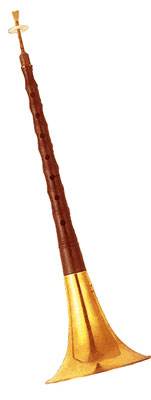Tone Hole Sound Sequence of Bai Suona
Almost every Bai village in Yunlong has folk artists who play suona. In Bai people's agricultural celebrations, weddings and funerals, folk festivals and folk activities, suona playing is an indispensable part. In different festivals, activities and different environments and ceremonies, there are strict regulations on the use of suona music.

The lowest tone (tube tone) of the Bai suona is generally between #g1 and b1. The common tone range of the suona is generally one and a half octaves. A small number of highly accomplished artists can play it to more than two octaves. The seven tones of the suona are The pitches of the seven fundamental tones produced by opening the first hole at the lower end of the void in sequence are a1, b1, c2, d2, e2, f2, and g2. Except for a1 and b1, which are obtained by opening the first and second holes in sequence, the other five tones, c2, d2, e2, f2, and g2, are obtained by closed and staggered fingering. When blowing these five notes, press the second hole to close, and the rest of the sound holes should be opened from the first hole to the original sound hole. f2 closes the fifth hole, and g2 closes the sixth hole. In addition to the function of changing the pitch by the closed hole of the two notes f2 and g2, the function of pressing the second hole when playing other notes is mainly to maintain the balance of the instrument when playing. The seven tones of a2, d2, c3, d3, e3, f3, and #f3 can be obtained by super blowing, which are basically obtained by the double-tone fingering of this hole. When playing these seven tones, except the two tones of a2 and b2 do not need to use the closed hole, the function of pressing the first hole or the first and second holes at the same time when playing the other five notes is also to keep the instrument playing. The balance of the sound has no effect on the pitch.
 渝公网安备 50010702504639号
渝公网安备 50010702504639号